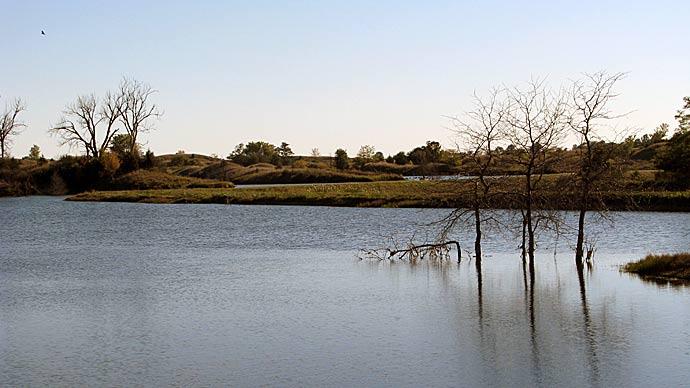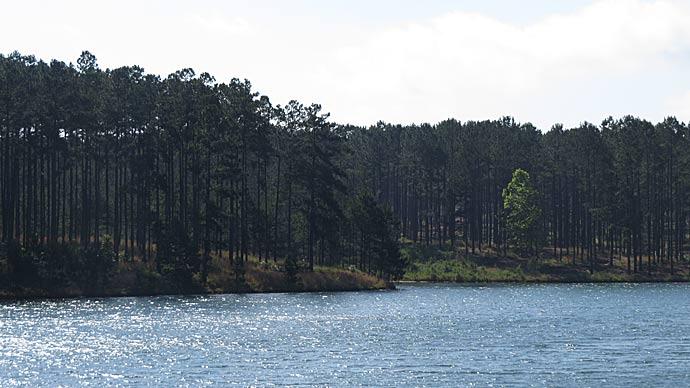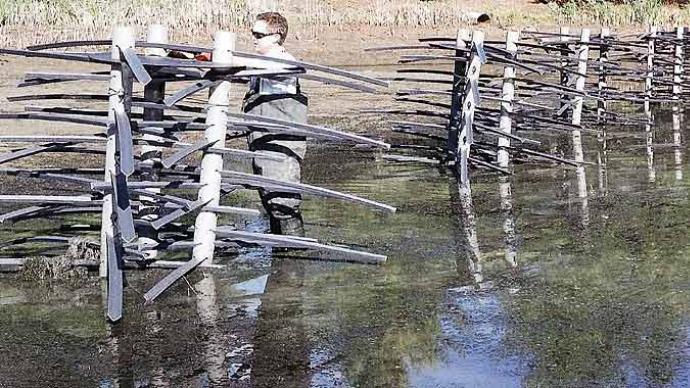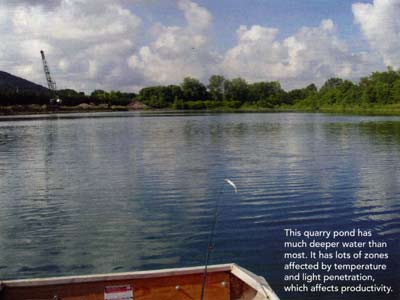
Have you stopped and wondered how a pond changes as you move offshore? Or to deeper water? The physical, chemical, and biological environment changes with depth into the water column—and with distance from shore.
One of the primary limiting factors that change with depth is light. Visible white light travels from the sun to the earth in the full ROYGBIV (rainbow) spectrum. Why is it called white light? That's the color of snow, reflecting the full spectrum to the viewer. As water depth increases, some light is reflected, and some is absorbed. Waves cause more light to be reflected. Light attenuation is the decrease in the intensity of light with increasing depth. As depth increases, light is extinguished vertically. Longer wavelengths, like reds, are first to be attenuated, and shorter wavelengths (like blues) penetrate deepest. Blue light penetrates deepest and backscatters to your eye, making deep, unproductive waters look very blue. A deep column of pure water with nothing dissolved would appear blue. Most of the light in the red and yellow part of the spectrum is attenuated in the top few meters of water. Plants appear green because that wavelength of light is reflected from the plant back to the viewer's eye.
Once light diminishes, submerged aquatic plants do not have enough light to grow. What is that depth? Commonly, and in our pond, it's about 7-8-feet. Rooted aquatic plants (like pond weeds) need sunlight penetrating the bottom of stable, soft sediments to grow. If the sunlight is diminished by increasing depth, the plants will not grow. This is also true if the plants are shaded by phytoplankton (green water), turbidity, or common brands of lake dye. During the construction of our pond, we purposely made the shoreline slope fall quickly to deep water to keep most of the pond weed-free by design. Steep and deep is how this style of shoreline is often described.
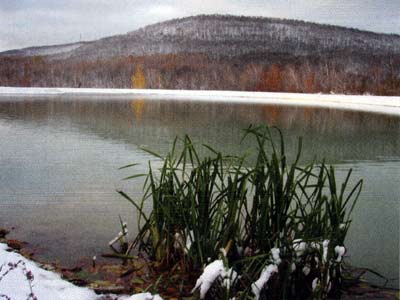
To recap, a good portion of light in the longer wavelength is attenuated in the top few meters of water. And most plants grow better with a full spectrum of light. Hence, the light below a certain depth is insufficient for rooted plant growth.
Vertical zonation and water temperature go together like hand and glove. Water density essentially causes vertical stratification. Density is influenced by temperature. Water is most dense at 4°C and will be at the bottom of a deep lake in winter and summer. In winter, a pond is vertically layered with surface ice floating at 0°C, then 1°C, 2°C, 3°C, with 4°C water on the bottom. Almost without exception, every ice-covered lake and pond will be stratified this way.
In a deep lake or pond in summer, colder water will be at the bottom, and warmer, less dense water will float at the top. The warm surface water interacts with the atmosphere; the colder, deeper water does not. Cold-water fish (trout) will be at the bottom, and the warm-water fish (sunfish and bass) will be in the warmer, shallow water. In spring and fall, these layers mix as the water reaches nearly 4°C and the pond turns over via density changes or wind.
This stratification profoundly affects the dissolved oxygen fish and other aquatic life needs. Fish are aerobes, meaning they need oxygen to live. This fact makes dissolved oxygen one of the ponds' most crucial water quality concerns. Warm water holds less oxygen, and cold water holds more, given a constant source. Dissolved oxygen gets into water from two primary pathways: (1) atmospheric diffusion and (2) photosynthesis from green plants. Dissolved oxygen concentrations may not be a problem in shallow ponds that uniformly mix often. But in deeper, productive ponds that stratify in winter (or summer), this deep water may become an area of consumption. All green production from algae and rooted plants dies, falls to the bottom, and decomposes. In deeper ponds in the Northeast, this zone may be cold but primarily anaerobic because oxygen is consumed as organic material is broken down by bacteria. Since the water is deep and stratified, the bottom waters of the pond do not mix with the atmosphere, and a deep, dead layer of water is formed that fish will not use. In a nutshell, respiration exceeds photosynthesis, and no diffusion from the atmosphere replenishes oxygen. If the anaerobic problem persists, summer or winter kill can occur when the anaerobic layer reaches the top. Monitoring this type of vertical zonation is essential.
How can it be fixed? Aerate...starting long before the problem exists.
Horizontal zonation describes the environment moving offshore. The nearshore edge of the pond is the perfect environment for growth. The intersection of sunlight, sediments, warm, shallow water, and the atmosphere makes this an area of maximum diversity. Put simply, the edge of the pond is an ecotone or edge area where all the action is. Rooted emergent plants like cattails, arrowheads, and rushes provide nearshore cover for small fish, aquatic insects, frogs, tadpoles, and other critters. Attached epiphytic algae grow on the surfaces of these plants and increase production even more. Water fleas and other crustacean zooplankton graze on abundant nearshore phytoplankton. Just below the nearshore surface, dead organic material breaks down on the bottom. This detrital material is used by detritivores like scuds. Benthic (bottom) invertebrate diversity and biomass often peak in 1-3-feet. Fathead minnows, sticklebacks, and banded killifish make their homes here. When this zone is windswept, and gravel is washed clean, bass and sunfish will nest. Young of the year, sunfish forage in this zone of plenty.
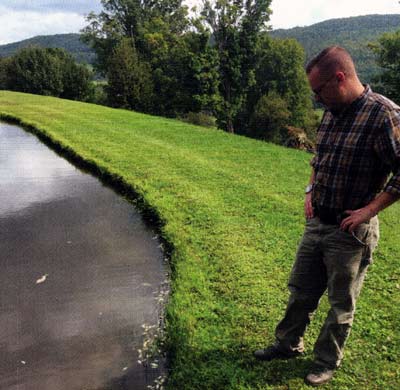
Moving a little further horizontally offshore, rooted aquatic macrophytes like pondweeds take over. Pondweeds like floating-leaf pondweed, variable-leaf pondweed, and American pondweed are found near shore. Bigleaf pond weed and others are deeper. Still deeper are tape grass, coontail, and musk grass or stonewort (really an algae) that carpets the deepest parts of clear ponds. Sometimes, this muskgrass reminds me of a carpet of AstroTurf and is one of the last plants to grow in the deeper water. This area of stable sediments and sufficient sunlight to grow plants is called the littoral zone. This zone is critically important to fish like sunfish, bass, and perch. These fish need the structure that plants provide and use them for finding food and cover. Bass like about 50% cover and 50% open water. In our pond, the weed-rooted plant zones end at 6-7-feet, and muskgrass grows to around 8' deep. Yellow perch string their tubes of gelatinous eggs on the springtime remains of those rooted plants. Moving further offshore (and deeper), the benthic zone (bottom) is primarily a mud bottom with some algae that can grow in very low light. A good oxygen supply to the benthic zone is vital for the pond's health.
The limnetic zone is the offshore, open-water zone outside the plants but above the deepest water. This area of open water is dominated by phytoplankton and the zoo-plankton that graze on them. Phytoplanktonic production (planktonic algae) is usually the most important production in most ponds and lakes. In other words, open water is vital to the food web of a pond because most fish start their lives by eating zooplankton. More zooplankton equals more baby fish and more bait fish. The rest of the fishy food chain follows. Phytoplanktonic green algae is best for the food chain, and brown and blue-green algae point to problems.
Why try to make sense of all of this information?
Recently, a student placed structures on the melting spring ice to provide focal points for fish and fishermen. The goal was to improve the local lake's habitat for bass, crappie, and yellow perch. One key factor in determining where to place these structures was depth. Structures were strategically placed 4-6 feet to maximize habitat in abundant light penetration and production zones. Placement was avoided in depths greater than 8 feet because that is too deep; structures placed too deep would not be used for most of the year. Additionally, the pond has an anaerobic zone in the summer and winter in the deepest water (greater than 12 feet) and a structure that would be in the dead zone for more than half of the year.
Similarly, rocks at the deep, open-water bottom of my pond (11 feet) rarely have fish around them, even though they are great-looking boulders. In contrast, boulders in 4-6 feet of water with a few pondweeds nearby are a fish haven.
Why?
These rocks are in the zone where all the action is. Think about zonation when altering or building pond habitat.
Mark Cornwell is a professor of fisheries at the State University of New York in Cobleskill, NY. Based near the Catskill foothills, he feeds the brains of hungry fish students, offering plenty of applied science and hands-on opportunities beyond the classroom. Cornwell also works with select local landowners, collecting data and analyzing ponds, with students also benefitting. He also assists the college's aquaculture department.
Reprinted with permission from Pond Boss Magazine

